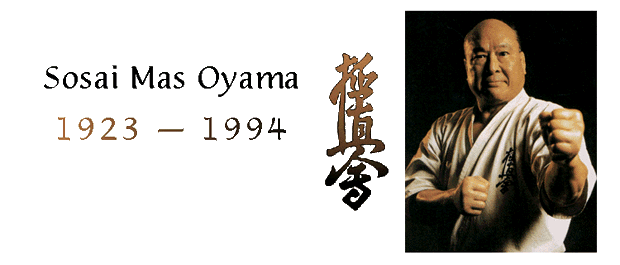|
|
 An
early start An
early start
Masutatsu (Mas) Oyama was born Yong I-Choi on the 27th of July, 1923,
in a village not far from Gunsan in Southern Korea. At a relatively
young age he was sent to Manchuria, in Southern China, to live on his
sister's farm. At the age of nine, he started studying the Southern
Chinese form of Kempo
called Eighteen hands from a Mr. Yi who was at the time working
on the farm. When Oyama returned to Korea at the the age of 12, he continued
his training in Korean Kempo.
In 1938, at the age of 15, he travelled to Japan to train as an aviator,
to be like his hero of the time, Korea's first fighter pilot. Survival
on his own at that age proved to be more difficult than he thought,
especially as a Korean in Japan, and the aviator training fell by the
wayside.
 Gichin
Funakoshi Gichin
Funakoshi
He did however continue martial arts training, by
participating in judo and boxing, and one day he noticed some students
training in Okinawan Karate. This interested him very much and he went
to train at the dojo of Gichin Funakoshi at Takushoku University,
where he learned what is today known as Shotokan
Karate.
His training progress was such that by the age of seventeen
he was already a 2nd dan, and by the time he entered the Japanese
Imperial Army at 20, he was a fourth dan. At this point he also
took a serious interest in judo, and his progress there was no less
amazing. By the time he had quit training in Judo,
less than four years after he had started, he had achieved the rank
of fourth dan in Judo.
 So
Nei Chu So
Nei Chu
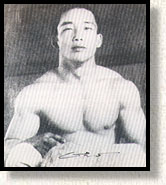
The defeat of Japan and the subsequent indignity of Occupation
almost proved to be too much for Mas Oyama, who nearly despaired. Fortunately
for all of us, So Nei Chu came into his life at that time. Master So,
another Korean (from Oyama's own province) living in Japan, was one
of the highest authorities on Goju Ryu in Japan at the time. He was
renowned for both his physical and spiritual strength. It was he who
encouraged Mas Oyama to dedicate his life to the Martial Way. It was
he too who suggested that Oyama should retreat away from the rest of
the world for 3 years while training his mind and body.
 Mountain
Training Mountain
Training
When he was 23 years old, Mas Oyama met Eiji Yoshikawa,
the author of the novel Musashi, which was based on the life
and exploits of Japan's most famous Samurai. Both the novel and the
author helped to teach Mas Oyama about the Samurai Bushido code
and what it meant. That same year, Oyama went to Mt. Minobu in the Chiba
Prefecture, where Musashi had developed his Nito-Ryu style of swordfighting.
Oyama thought that this would be an appropriate place to commence the
rigours of training he had planned for himself. Among the things he
took with him was a copy of Yoshikawa's book. A student named Yashiro
also came with him.
The relative solitude was strongly felt, and after 6 months,
Yashiro secretly fled during the night. It became even harder for Oyama,
who wanted more than ever to return to civilisation. So Nei Chu wrote
to him that he should shave off an eyebrow in order to get rid of the
urge. Surely he wouldn't want anyone to see him that way! This and other
more moving words convinced Oyama to continue, and he resolved to become
the most powerful karate-ka in Japan.
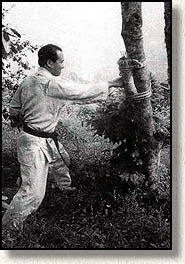 Soon
however, his sponsor informed him that he was no longer able to support
him and so, after fourteen months, he had to end his solitude. Soon
however, his sponsor informed him that he was no longer able to support
him and so, after fourteen months, he had to end his solitude.
A few months later, in 1947, Mas Oyama won the karate
section of the first Japanese National Martial Arts Championships after
WWII. However, he still felt empty for not having completed the three
years of solitude. He then decided to dedicate his life completely to
karate-do. So he started again, this time on Mt. Kiyozumi, also in Chiba
Prefecture. This site he chose for its spiritually uplifting environment.
This time his training was fanatical — 12 hours a day every
day with no rest days, standing under (cold) buffeting waterfalls, breaking
river stones with his hands, using trees as makiwara, jumping
over rapidly growing flax plants hundreds of times each day. Each day
also included a period of study of the ancients classics on the Martial
arts, Zen, and philosophy.
After eighteen months he came down fully confident of himself,
and able to take control of his life. Never again would he be so heavily
influenced by his society around him. (Though it is probably safe to
say that his circumstances were also probably never again as traumatic!)
 Bulls,
Challengers, and the Godhand Bulls,
Challengers, and the Godhand
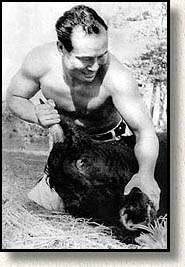
In 1950, Sosai (the founder) Mas Oyama started testing
(and demonstrating) his power by fighting bulls. In all, he fought 52
bulls, three of which were killed instantly, and 49 had their horns
taken off with knife hand blows. That it is not to say that it was all
that easy for him. Oyama was fond of remembering that his first attempt
just resulted in an angry bull. In 1957, at the age of 34, he was nearly
killed in Mexico when a bull got some of his own back and gored him.
Oyama somehow managed to pull the bull off and break off his horn. He
was bedridden for 6 months while he recoverd from the usually fatal
wound. Today of course, the animal rights groups would have something
to say about these demonstrations, despite the fact that the animals
were already all destined for slaughter.
In 1952, he travelled the United States for a year, demonstrating
his karate live and on national televison. During subsequent years,
he took on all challengers, resulting in fights with 270 different people.
The vast majority of these were defeated with one punch! A fight
never lasted more than three minutes, and most rarely lasted more than
a few seconds. His fighting principle was simple — if he got through
to you, that was it.
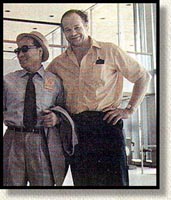 If
he hit you, you broke. If you blocked a rib punch, you arm was broken
or dislocated. If you didn't block, your rib was broken. He became known
as the Godhand, a living manifestation of the Japanese
warriors' maxim Ichi geki, Hissatsu or "One strike, certain death".
To him, this was the true aim of technique in karate. The fancy footwork
and intricate techniques were secondary (though he was also known for
the power of his head kicks). If
he hit you, you broke. If you blocked a rib punch, you arm was broken
or dislocated. If you didn't block, your rib was broken. He became known
as the Godhand, a living manifestation of the Japanese
warriors' maxim Ichi geki, Hissatsu or "One strike, certain death".
To him, this was the true aim of technique in karate. The fancy footwork
and intricate techniques were secondary (though he was also known for
the power of his head kicks).
It was during one of his visits to the United States
that Mas Oyama met Jacques Sandulescu,
a big (190 cm and 190 kg of muscle) Romanian who had been taken prisoner
by the Red Army at the age of 16, and sent to the coal mines as a slave
labourer for two years. They quickly became friends and remained so
for the rest of Oyama's life, and Jacques still trains and acts as advisor
to the IKO(1) to this day. You can read a short
biography of his on this site or read his autobiography at http://donbas.com.
 Oyama
Dojo Oyama
Dojo
In 1953, Mas Oyama opened his first "Dojo", a grass
lot in Mejiro in Tokyo. In 1956, the first real Dojo was opened in a
former ballet studio behind Rikkyo University, 500 meters from the location
of the current Japanese honbu dojo (headquarters). By 1957 there were
700 members, despite the high drop-out rate due to the harshness of
training.
Practitioners of other styles came to train here too, for
the jis-sen kumite (full contact fighting). One of the original
instructors, Kenji Kato, has said that they would observe those from
other styles, and adopt any techniques that "would be good in a real
fight". This was how Mas Oyama's karate evolved. He took techniques
from all martial arts, and did not restrict himself to karate alone.
The Oyama Dojo members took their kumite seriously, seeing
it primarily as a fighting art, so they expected to hit and to be hit.
With few restrictions, attacking the head was common, usually with the
palm heel or towel-wrapped knuckles. Grabs, throws, and groin attacks
were also common. Kumite rounds would continue till one person loudly
conceded defeat. Injuries occurred on a daily basis and the drop out
rate was high (over 90%). They had no official do-gi and wore
whatever they had.
 Bobby
Lowe Bobby
Lowe
In 1952, Mas Oyama gave a demonstration in Hawaii.
A young Bobby Lowe saw him and was stunned by the power Oyama demonstrated.
It was not as though Bobby Lowe was inexperienced in martial arts. Though
still quite young, his achievements to date were not much less than
those of Mas Oyama himself. His father had been a Kung Fu instructor,
and he had participated in any fighting art he could find. By the age
of 23, he was yondan in judo, nidan in kempo, shodan
in aikido, and a highly regarded welterweight boxer.
It was not long before Bobby Lowe became the first Kyokushin
uchi deshi or "live-in student" of Mas Oyama's. He trained daily
with Mas Oyama for one and a half years. Eventually, an uchi deshi's
time became "1000 days for the beginning". These uchi deshi became
known as Wakajishi, or the "Young Lions" of Mas Oyama and only
a few of the hundreds of applicants were chosen each year for the privilege
of training full time under the Master.
In 1957, Bobby Lowe returned to Hawaii to open the first School
of Oyama outside Japan.
 The
beginning of Kyokushin The
beginning of Kyokushin
The current World Headquarters were officially opened
in June 1964, where the name Kyokushin, meaning "Ultimate
truth" was adopted. From then, Kyokushin continued to spread to more
than 120 countries, and registered members exceed 10 million making
it one of the largest martial arts organisations in the world. Among
the the better known Kyokushin yudansha (black belts) are Sean
Connery (Honorary shodan), Dolph Lundgren (sandan, former
Australian heavyweight champion), and President Nelson Mandela of South
Africa (Honorary hachidan), and most recently (June 1988), the
Australian Prime Minister, John Howard (Honorary godan) who was
awarded the grade at the official opening of the one of the dojo in
Sydney.
 The
End? The
End?
Sadly, Sosai Mas Oyama died, of lung cancer (though
nominally a non-smoker, it's rumoured that he did enjoy cigars - can
anyone confirm/deny this?), at the age of 70 in April 1994, leaving
the then 5th dan Akiyoshi
Matsui in charge of the organisation. This has had many political
and economic ramifications throughout the Kyokushin world, which are
still being resolved. In the end, the result may well be a splintering
of Kyokushin, much like Shotokan now appears to have done, with each
group claiming to be the one-and-only true heir of Mas Oyama's Kyokushin,
either spiritually or even financially. It has even been suggested,
not entirely in jest, by one Kyokushin commentator in Australia (Harry
Rogers) that maybe Oyama created the turmoil on purpose, because he
didn't want Kyokushin to survive without him! It is however reasonably
certain that all Kyokushin groups, regardless of their ultimate allegiance,
will still try to maintain the standards set by Mas Oyama.
Maybe a Kyokushin diaspora will be a good thing, since in
all good families, some of the children eventually do leave home and
start their own families. Some of the splinter
groups may remain faithful to the Kyokushin principles, such as
Hanshi Steve Arneil in
Great Britain did in 1991. Many others, such as Shigeru
Oyama in the U.S., have taken it further by developing their own
style based on Kyokushin.
|
|


